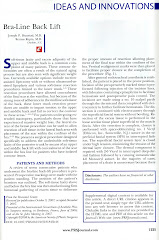What is a mini tummy tuck?
The best description of a mini tummy tuck is that it has a shorter horizontal scar at the waistline without the need for a scar around the belly button. There is some variation to the other components of the mini tummy tuck procedure. This includes whether the abdominal wall is plicated/tighten and whether the stalk of the umbilicus is detached or left alone.
Often, the mini tummy tuck is performed by dissection of the soft-tissue up to the level of the belly button. The excess soft-tissue is removed, but there is no muscle tightening performed and the belly button stalk is usually left undisturbed. The decision of which components of the mini tummy tuck are performed should be based on the needs and goals of the patient.
Who is a candidate for the mini tummy tuck?
The ideal candidate for a mini tummy tuck is someone that is close to their normal body weight and who have some, but not a significant amount of excess skin and soft-tissue laxity. In essence, the mini tummy tuck patient does not have enough abdominal laxity that will safely allow resection of the excess skin and soft-tissue from the initial waistline incision up to and including the location of the belly button. A standard or full tummy tuck in these patients would create a vertical scar in the midline of the abdomen between the new location of the belly button and the location of the final waistline scar.
How long is the scar?
There is some flexibility in how long the scar of a mini tummy tuck can be. Although the exact length may vary, the ends of the scar should not go beyond the first prominent point of the pelvic bone. This point is referred to as the anterior superior iliac spine (ASIS). Any tummy tuck scar that extends beyond these points implies that the laxity of the abdominal soft-tissue were more than moderate and the patient may be a decent candidate for a standard full abdominoplasty.
What are the pros and cons of the mini tummy tuck?
The mini tummy tuck procedure is designed for patients that have some laxity of the abdominal soft-tissue but not enough to allow a full abdominoplasty to be performed. The pros are that the total length of the scar is shorter and the need for a scar around the belly button is avoided. The recovery time, cost, and the other variables may be quite similar since some surgeons, myself included, perform most of the other components of a standard tummy tuck if deemed beneficial to the overall result. These may include liposuction of the abdomen, hips, flank, and mons area as well tightening of the abdominal muscles. To do so, the belly button can be detached to allow access to the entire length of the abdominal muscles and then reattached at the completion of the case.
The cons are seen only when the mini tuck is used for patients that are not ideal candidates. These include patients with significant laxity, poor skin that may have stretch marks up to or beyond the belly button, and a belly button size, shape, and position that would benefit from rejuvenation. The mini tummy tuck is simply not designed to accomplish all of this.
We have mentioned, and will be discussing abdominal muscle tightening with many of the other tummy tuck procedures. In order to better understand this process a post specifically on abdominal muscle tightening or myofascial plication will be made in the next few days. Stay tuned.
All the best,
Dr. Remus Repta
Tummy tuck: is it worth it? Tummy tuck (Abdominoplasty) reviews, cost, results, photos, side effects







